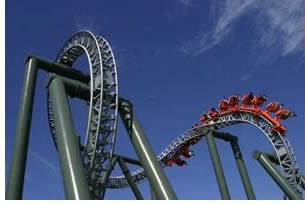

A Definitive Examination of the Price of Steel
by John P. Cross, PE
The United States market for construction materials has exhibited significant volatility from late 2003 through November 2004. This volatility has impacted the costs of projects and the availability of materials required to complete projects. As of mid-November typical price increases on projects are ranging from 12 percent to 20 percent.
Projects in some areas of the country are being delayed as a result of the short supply and long lead times for certain materials.
- Project owners are wrestling with the financial implications of increased project costs.
- Architects are concerned about the impact their design decisions will make on the predictability of project budgets.
- Structural engineers are unsure of what framing systems to utilize on new projects based on the availability of necessary components.
- General contractors fear schedule interruptions and upward price pressure from specialty contractors.
- Specialty contractors are caught between the competitive pressures of low bid contracts and the lack of predictability of material costs.
No matter whether the focus of attention is on copper piping, gypsum products, plywood, sprinkler pipe, ductwork, structural steel, concrete, or reinforcing steel, the last 12 months bear more resemblance to a trip to an amusement park than orderly commerce. And like any amusement park ride, each rider needs to make certain decisions based upon the experience of the ride.
You end up back where you start
For all of the excitement and volatility of the ride, you really don’t
go anywhere. The volatility of the past 12 months has not resulted
in increased productivity in the construction industry or new design
techniques. Design and construction are being performed in the same
way. But after all the ups and downs, the rider has a choice: walk
away from the ride and hope that life will be smooth from that point
on or turn around, look at the ride, and ask why it was such a wild
experience.

The volatility of today’s market shows no signs of dissipating . . . there is no promise of level ground. Instead, the wise design/construction professional must turn around and attempt to understand the reasons behind the dynamics of the past 12 months.
First, construction material volatility has not been limited to a single product or material. While steel has received the majority of coverage in the press, all construction materials are exhibiting similar trends. In some cases the volatility has expressed itself primarily in terms of price, in other cases availability. Even within components with the same base material the impact has been different. Wide flange structural steel has increased in price at the mill level by 56 percent but is readily available in the marketplace. Reinforcing steel for concrete applications has increased 65 percent in cost and has been in short supply.
Ready-mix concrete has increased in cost by 7 percent but is on allocation in some areas of the country. Plywood used for forming systems is up 210 percent since January 2003 as part of an overall lumber increase of 27 percent.
Second, the construction materials market is highly sensitive where any one of a number of factors can trigger volatility. In the initial stages of the current round of instability all fingers pointed to China as a source of growing demand for raw materials, particularly scrap materials. Yet, over the past several months, the market for various materials has been impacted by events without any direct connection to Chinese scrap demand. Global demand for construction materials has increased, ocean shipping resources have been in short supply and of high cost, rail cars are unavailable to move scrap and product within the United States, other nations have limited or terminated exports of scrap and construction materials, the U.S. dollar has weakened limiting imports, material producers have modified their processes and product mixes as a function of energy and demand requirements resulting in increased domestic competition for resources, and price speculation on the part of raw material purchasers has created uneven demand cycles.
Third, a transition is occurring from the pricing of domestic construction materials being based on a cost of production model to pricing being based on a global demand model. The United States construction market is changing. No longer will prices be determined by domestic production and demand, but by the relative value of products as part of the global market. As other countries grow in their demand for construction materials, such as China and India, U.S. builders will see materials priced on a global basis.
Why? Their appetite for these materials will exceed our domestic consumption. This transition is already occurring. In November 2004 the typical market price for structural steel from a producing mill was $595 per ton—$123 per ton of that price reflects the increased impact of scrap prices since November 2003. During the same period, the base price of the steel has increased by $92 per ton reflecting global demand and pricing for structural steel. Today, the domestic price of structural steel is still below global levels. For the past 20 years, the mill price of structural steel has been very stable. The steel industry’s ability to maintain that stability has been a direct result of increases in mill efficiency.
In the early 1980s, it took 10 man hours to produce a ton of steel. Today, a ton of steel requires less than a single man hour. While other materials gradually increased in cost, steel remained stable. Even today, the index price of steel against a 1980 base remains below the index prices of competing materials. The bottom line is that volatility is a trend that will be present on a long-term basis. It will continue to affect all construction materials. Even when brief periods of stability occur, it should be anticipated that volatility will return to the marketplace in the near term.
 Rides are designed to be exciting
Rides are designed to be exciting
Some rides are more thrilling than others, but they are all meant to
be exciting and provide entertainment. Some generate thrills by vertical
climbs and drops. Others induce G forces through tight spins and
turns. Still others depend on visual imagery and fear to entertain.
While no one in the design/construction community would consider
the past 12 months entertaining, it is worthwhile to consider the
different types of rides that have been experienced with different
types of materials.
When evaluating the market behavior of various construction materials it is helpful to view that behavior through a defined framework. Perhaps the most helpful framework is that of the 5 Vs: Volume, Variety, Velocity, Value, and Volatility.
Volume is a measure of the capacity of the market to supply the demand of the marketplace. The concrete industry is dependent on a significant percentage of imported cement to satisfy domestic demand. Overall, nearly 20 percent of cement used in the United States is imported. In some areas of the country, such as Florida, over 40 percent of cement is imported. Recent shipping and supply problems have limited the capacity of the market to supply the growing demand of the construction marketplace. This volume constriction has created allocations and project delays in 20 states.
In contrast, the domestic structural steel industry has an annual capacity to produce nearly 6 million tons of wide flange structural shapes. In 2004, domestic demand will approach 4 million tons. This excess capacity translates into adequate volume to meet both the current and long-term demands of the domestic market. This is not true of all segments of the steel industry. Capacity restrictions are affecting sheet-rolled and plate products, which impact pipe, tube, plate, and sheet metal products.
Velocity is the measure of the speed at which the supply can reach the end user. Even if excess capacity exists in the production process, availability problems will still exist if that process cannot meet the demand for specific products. Structural steel mills are on an industry standard six- to eight-week rolling cycle where their product line is produced within a single cycle. In addition, steel service centers stock one million tons of steel (25 percent of annual demand) of all sizes for delivery on an immediate demand basis.
Also impacting the velocity component of a construction material is the availability of transportation to move material from production locations to project sites. This may be the largest challenge on the horizon for all construction materials.
Variety is a measure of the different number items within a product family that are being utilized in the marketplace. During the past months certain materials such as metal studs, reinforcing bars, and post-tensioning strand have been difficult to obtain. Because these products have few variations (a limited number of items within the product family) some contractors, pre-casters, and rebar fabricators have increased their inventories making the product scarcer and even more difficult to obtain in the general marketplace.
Structural steel provides a clear image of the opposite condition. Because such a large variety of structural shapes are used in building construction, it is not financially feasible for a steel fabricator to stock material on a speculative basis. The result of this product variety combined with adequate volume and efficient velocity is that wide-flange structural steel members are readily available in the construction marketplace today and for the foreseeable future.
Value is a measure not of the absolute cost of the material, but the relative cost for equivalent value that a product brings to the marketplace. Much has been written about the impact of rising steel prices on overall project costs. To determine the value component it is necessary to step back and evaluate the impact that changing prices have on project costs as compared to competing materials.
Click here for a discussion of the comparative value of steel versus concrete.
In today’s marketplace the overall comparative value of alternative structural systems has remained relatively unchanged. This means that the bottom line for the owner, architect, structural engineer, or general contractor is that when evaluating the value of selecting a particular structural material on a particular project, a current comparison must be made of competing systems rather than relying on traditional rules of thumb.
In addition, care should be taken to evaluate the total project cost using competing structural systems, not just the structural frame itself. Often using steel framing can result in reducing foundation and other project costs—these differences must be taken into account.
Volatility is the predictability of the price and availability of a construction material. There can be no question that over the past 12 months all construction materials have experienced significant volatility characteristics. This volatility has manifested itself across the board with all materials. Some materials, notably cement and concrete, have experienced “smoother” price increases, while other materials, such as structural steel have been more erratic in pricing behavior. On the flip side, steel supply is much more predictable than the cement/concrete supply.
 Learning to reduce the risk
Learning to reduce the risk
The past 12 months have been a learning experience, but who really
wants to relive that experience? So the next natural question is:
How can the risk and impact be reduced when volatility remains a
fact of life?
First, recognize the key role that specialty contractors play in the overall construction process. No longer is the specialty contractor a commodity provider who simply delivers and installs material at a project site. The specialty contractor brings expertise regarding material pricing, cost-saving techniques, project coordination, and working with material suppliers that owners, architects, general contractors, construction managers, and structural engineers do not possess. Why? Because specialty contractors, like steel fabricators, live the challenges of their slice of the project over and over again.
Specialty contractors are well-prepared by experience and knowledge to deal with the challenges and assume some of the project risks. But that can’t happen if the specialty contractors are not brought into a project until bid time. To lessen the risks of construction material volatility, bring the specialty contractor in early to the project and integrate them into the design and construction team.
In terms of structural steel, integrating a certified steel fabricator early into the project team can bring significant advantages. Fabricators monitor steel pricing on a continuous basis and can recommend value engineering opportunities. Designs can be directly influenced to take into account fabrication and erection efficiencies. Fabricators can also recommend other cost-saving strategies, such as the use of electronic model exchange between design, detailing, and fabricating programs. The cost savings available through this technique often exceed the recent increases in mill material cost.
Reductions between 10 and 20 percent in the cost of the steel package and schedule savings approaching 50 percent of the time traditionally allocated for steel design, fabricator selection, detailing, mill orders, fabrication, transportation, and erection are not unusual.
Second, recognizing that during a period of price volatility for any type of product the shorter the amount of time between accepting bids, selection notification, and authorization to proceed is advantageous. If you want a specialty contractor to lock price on a project, be prepared to hear from them that they will need to turn the project from bid submission to material order in a period of days, not weeks or months. Related to this is the possible need to purchase all materials upon authorization to proceed even if the project may extend over a significant period of time. Early material purchase is a hedge against unexpected cost increases, but will require payment by the project to the specialty contractor for the material costs and storage when incurred rather than when installed.
Third, it is necessary to make sure that all parties are approaching the global market volatility on a realistic basis. Some specialty contractors may suggest including “price adjustment” clauses in their contracts. Whether such clauses should be used on individual contracts is an individual decision that needs to be made on a job-by-job and company-by-company basis and then used uniformly by all bidders. If such a clause is selected, it should be structured to be as accurate and as fair to all concerned as possible.
Finally, the current volatility in construction materials should drive the design/construction industry to review current contracting practices. The construction industry has not kept pace with the productivity increases in other industries. Current increases in material costs can and should be offset by productivity gains. The greatest opportunity for these gains occurs not on the project site, but in the design office and in the automated offsite fabrication facilities of specialty contractors.
Not all risk can be removed from the construction-material ride, but the specter of continued volatility calls for changes in design and construction practices to share and minimize that risk.
 Motion sickness is different than butterflies
Motion sickness is different than butterflies
There is a big difference between feeling a few butterflies in the
stomach on a new ride or a long drop compared to the effects of fullfledged
motion sickness. It’s natural to be nervous when approaching
a project in volatile times. It’s natural to feel some butterflies
as new approaches to construction and involvement of specialty contractors
are attempted. It’s natural to desire to evaluate competing structural
systems when the butterflies of volatility flutter. Alternative structural
systems should be rationally and fully evaluated. But motion sickness
can result in emotional rather than rational decisions to change structural
systems and materials.
There is no need to experience motion sickness in today’s marketplace. Experienced professionals at all levels of the design and construction process can provide the support that will result in successfully constructed projects.
Copyright 2004 The American Institute of Architects.
All rights reserved. Home Page ![]()
![]()
 |
||
| John Cross
is vice president of American Institute of Steel Construction Marketing,
LLC.
For more information about the American Institute of Steel Construction,
visit their Web site. The structural steel industry is positioned to help beat the butterflies and evaluate innovative framing techniques, technological improvements, cost, schedule, and new systems for your projects, John Cross says, both through individual fabricators and the AISC Steel Solutions Center, 866-ASK-AISC or solutions@aisc.org.
|
||